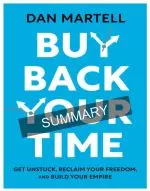
Atomic Habits: Practical Summary
Core Philosophy
Small changes compound into remarkable results. Getting 1% better every day leads to being 37 times better after a year. Focus on systems, not goals - you don't rise to the level of your goals, you fall to the level of your systems.
This systems-first approach is especially powerful for entrepreneurs looking to scale their businesses. For a deep dive into applying systems thinking to buy back your time and build a thriving business, check out our Buy Back Your Time summary.
The Habit Loop
Every habit follows 4 steps:
- Cue - triggers your brain to initiate behavior
- Craving - motivational force behind the habit
- Response - the actual habit you perform
- Reward - the benefit you gain from doing the habit
The Four Laws of Behavior Change
1st Law: Make It Obvious
For Good Habits:
- Habit Stacking: "After I [current habit], I will [new habit]"
- Implementation Intentions: "I will [behavior] at [time] in [location]"
- Environment Design: Make cues for good habits visible
- Habits Scorecard: List daily habits and rate them +, -, or =
For Bad Habits:
- Make cues invisible (remove phone from bedroom, hide junk food)
2nd Law: Make It Attractive
For Good Habits:
- Temptation Bundling: Pair something you need to do with something you want to do
- Join cultures where your desired behavior is normal
- Motivation Rituals: Do something enjoyable before a difficult habit
For Bad Habits:
- Highlight the benefits of avoiding the bad habit
3rd Law: Make It Easy
For Good Habits:
- Two-Minute Rule: Scale habits down to take less than 2 minutes
- Prime Your Environment: Prepare your space for success
- Reduce friction between you and good habits
- Automate: Use technology and one-time decisions
For Bad Habits:
- Increase friction (unplug TV after use, delete social media apps)
4th Law: Make It Satisfying
For Good Habits:
- Habit Tracking: Mark an X on calendar after completing habit
- Immediate Rewards: Give yourself a small reward after completing habit
- Never miss twice in a row
For Bad Habits:
- Habit Contracts: Make breaking bad habits costly or embarrassing
- Get an accountability partner
Practical Tools
Habit Stacking Examples
- "After I pour my morning coffee, I will write in my gratitude journal"
- "After I sit down for dinner, I will put my phone in another room"
- "After I put on my running shoes, I will text someone where I'm going"
Implementation Intentions Examples
- "I will exercise for 30 minutes at 6 AM in my living room"
- "I will read for 20 minutes at 9 PM in my bedroom"
Two-Minute Rule Examples
- "Read before bed" → "Read one page"
- "Do yoga" → "Take out yoga mat"
- "Study for class" → "Open my notes"
Environment Design
- For Reading: Place books around your house
- For Exercise: Lay out workout clothes the night before
- For Healthy Eating: Keep fruits visible, hide junk food
- For Focus: Remove distracting apps from phone
Identity-Based Habits
Don't just focus on outcomes - focus on becoming the type of person who does these things:
- Instead of "I want to lose weight" → "I am becoming someone who never misses workouts"
- Instead of "I want to read more" → "I am becoming a reader"
- Each habit is a vote for the type of person you want to become
Advanced Strategies
Habit Tracking
- Track your most important habit consistently
- Use the formula: "After I [habit], I will track it"
- Focus on showing up, not perfection
Recovery from Setbacks
- Never miss twice - missing once is an accident, twice starts a new habit
- Focus on getting back on track quickly rather than being perfect
Reflection and Review
- Regularly review what's working and what isn't
- Adjust your systems based on results
Quick Start Guide
- Choose ONE habit to focus on
- Make it obvious: Decide when and where you'll do it
- Make it attractive: Pair it with something you enjoy
- Make it easy: Use the Two-Minute Rule
- Make it satisfying: Track your progress and celebrate small wins
- Stack it: Link it to an existing habit
- Prime your environment: Set up your space for success
The key is starting small and being consistent. Master the art of showing up before worrying about optimization.
📚 Related Reading
Build Your Business Systems:
Buy Back Your Time Summary - Apply systems thinking to scale your business and reclaim your freedom through the Buyback Principle
Productivity & Focus:
Eat That Frog! Summary - Essential time management principles that complement atomic habits for maximum productivity
Psychology & Decision Making:
The Psychology of Money Summary - Understand the psychological patterns behind financial habits and long-term wealth building
Book: Atomic Habits by James Clear Summary by: www.booksummary.xyz


